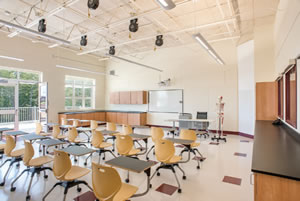Cleaner Air, Better Students
- By Michael Fickes
- 04/01/17

PHOTO © BLIND DOG PHOTO ASSOCIATES
Does your school district have an Indoor Air Quality (IAQ) management program in place? If not,
you might want to consider developing one and implementing
it. A number of studies show that students and teachers
perform better when breathing good, clean air.
According to the U.S. Environmental Protection Agency (EPA),
approximately one-half of the K-12 school buildings in the U.S.
have IAQ deficiencies.
What causes poor IAQ? There are several possible causes says
Dave Story, PE, senior associate mechanical engineer with Harriman,
an engineering firm based in Auburn, Maine. “Someone may
close the outside air dampers as a way to save energy,” he says. “Or
the outside air dampers could fall out of adjustment or fail.
“The air handling system could be set up wrong in the first place.”
Any one of these problems will reduce or even block the flow of
fresh air into a building and eventually reduce the quality of IAQ.

PHOTO © BLIND DOG PHOTO ASSOCIATES
Fresh Air. After years of struggling with inadequate space and environmental
and health hazards, voter approve the new Wentworth Intermediate
School in Scarborough, Maine. The new 800-student school has
modern building systems and geothermal heating and cooling that is
projected to save up to $70,000 in annual energy costs. The systems also
are designed to introduce up to 100 percent of outdoor air. Providing the
fresh air improved the IAQ throughout the school.
And poor IAQ can create a number of problems. According
to the EPA, poor IAQ affects the health and comfort of students,
teachers and administrators, which in turn has an adverse effect
on performance. What’s worse, the EPA notes that poor IAQ can
cause short- and long-term health problems, require costly repairs
and even give rise to liability problems for the school district.
In severe cases, schools have been required to close and
temporarily relocate faculty, staff and students — a very costly
undertaking.
As might be expected then, taking steps that improve IAQ
will improve performance. A 2015 study that appeared in the
“Journal of Environmental Economics and Management”
reported that the performance of students in one Texas school
district improved “significantly” following projects that raised
the quality of indoor air.
In response to such reports about the beneficial effects of better
indoor air, approximately half — 50 percent — of the more than
13,500 school districts across the U.S. have reported implementing
IAQ management plans.
Eighty percent of those programs have turned to the Environmental
Protection Agency’s (EPA’s) “Indoor Air Quality Tools for
Schools” for guidance.
The EPA Tools for Schools program recommends 11 specific
steps to improving IAQ:
- Familiarize yourself with EPA videos about IAQ. These include
the “IAQ Tools for Schools Action Kit” and “Taking Action & Ventilation Basics” and “IAQ Walkthrough.”
- Appoint an IAQ Coordinator to manage the IAQ program.
- Put together an IAQ Team that includes students, teachers,
administrators and representatives from each group
within the school.
- Research IAQ throughout the various rooms in the school.
- Identify IAQ problems using the IAQ Tools for Schools checklists.
- Review the problems you have identified.
- Conduct a walk-through inspection of the school.
- Prioritize and resolve IAQ problems, beginning with
health and safety.
- Set IAQ policies and develop an IAQ management plan.
The EPA has published a model plan.
- Follow up on your plan with inspections aimed at assessing the
quality of your problem solving performance. Schedule IAQ
events and set up a filing system for IAQ information.
- As you begin to manage IAQ effectively, become a mentor for
other schools.
The EPA recommendations stem from a U.S. Department of
Education National Center for Education Statistics report filed
years ago — in the year 2000. That report found that one-quarter
of U.S. school district buildings requires extensive repairs.

PHOTO © BLIND DOG PHOTO ASSOCIATES
The EPA recommends that school districts implement IAQ
programs in all schools district-wide. The EPA, however, does not
require compliance with its recommendations, nor does it require
recordkeeping related to IAQ. Then again, a number of states have
enacted legislation setting IAQ standards.
An IAQ Plan in Action
The Wentworth Intermediate School in Scarborough, Maine,
has implemented an IAQ program developed by Harriman.
Throughout the school, ventilation needs vary for different
spaces. Ventilation needs, of course, depend on how different
spaces are used, the number of people using the space and the
square footage of the space.
Fourteen custom modular indoor air handing units provide
ventilation at Wentworth. Each unit can deliver 100 percent
outdoor air.
To raise the level of ventilation effectiveness, fresh laminar air
enters the rooms low, from the base of the walls. Heat produced by
occupants and equipment rises up and creates a natural plume of
used air that returns to the air handler.
A portion of the air is exhausted to the outside by the air
handler and replaced with fresh air. Discharge air temperature
for a displacement system is lower in the winter and higher in the
summer. Managing a displacement system carefully can reduce
the energy needed to heat or cool the air.
Such ventilation can also help to deal
with potential carbon dioxide monitoring.
At the Wentworth school, Harriman
installed a carbon dioxide monitoring
system the constantly checks carbon dioxide
levels inside and outside the school’s
buildings.
Get Down on the Floor
Generally speaking, most ventilation
systems distribute air through vents
placed high on the walls or in the ceiling.
Harriman systems, however, go against the
traditional grain.
“Typically a classroom or office building
ventilates with an overhead distribution
system,” says Harriman’s Story. “We
ventilate at the floor — from zero to four
feet, and we provide room neutral air, close
to the temperature users want.

PHOTO © BLIND DOG PHOTO ASSOCIATES
“Systems with floor displacement diffusers
have been our standard practice for
about five years now — so this is relatively
new in the industry.”
The story goes on to say that floor diffusion
systems can ventilate with lower
airflow, which in turn requires less energy
to heat and cool. “We’re not mixing air,”
he says. “We’re just delivering air to the
occupied zone, and so we’re only heating or
cooling air at the desired room temperature.
This is how the Harriman approach to
improving IAQ in a room — by providing
fresh air at the breathing zone and not mixing
it. It is a displacement system that does
not require as much heating or cooling of
the air as a traditional system.
“We also use radiant flooring, which
provides even heat across a room,” Story
continues. “A traditional system uses thin
tubing around the bottom perimeter of a
wall. The tubing carries water heated to 180
degrees. It takes a fair amount of energy to
heat water to that temperature.
Harriman’s radiant flooring system
places tubes beneath the flooring and uses
water heated only to 80 degrees. The water
passes heat to the flooring surface, which,
in turn, radiates into the room — there is
no need to use energy to blow hot air into
a room.
Story goes on to point out the even
more savings can come from generating
hot water. “Because this system uses hot
water at lower temperatures than traditional
systems,” he says, “it is possible to
replace a traditional hot water heater with a
condensing boiler.”
A condensing boiler, says Story, operates
at an efficiency rate of 95 percent,
compared to an 83-percent efficiency rate
for a traditional boiler.
All told, then, healthy indoor air quality
enables the occupants of a school building
to function at peak efficiency. In addition,
maintaining healthy IAQ will make it
possible to manage a building’s operating
costs more effectively and, in some cases,
actually reduce those costs.
This article originally appeared in the issue of .